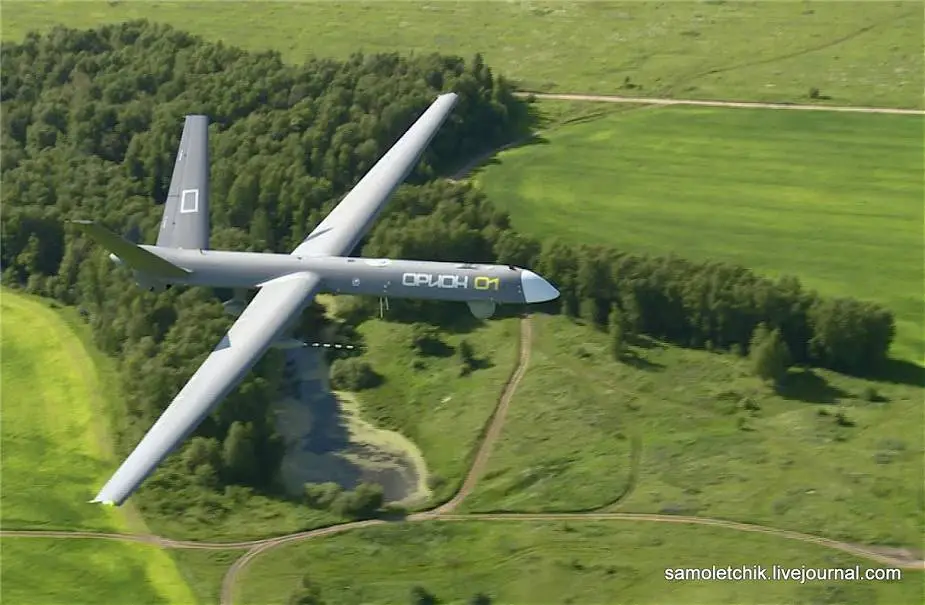The Russian Defense Ministry plans to adjust drone development plans according to the Syrian experience and the war in Nagorno-Karabakh. The target figures for various drones can be reviewed. Design priorities may also change. The Izvestia daily writes which programs are likely to be developed or closed.
Follow Air Recognition on Google News at this link
 Russian-made Okhotnik drone. (Picture source Russian MoD)
Russian-made Okhotnik drone. (Picture source Russian MoD)
Combat drones played a key role in three conflicts in 2020, expert Vladislav Shurygin said. “Turkey used them to stop the Syrian advance in Idleb. In Libya, drones changed the situation and pushed Haftar troops away from Tripoli. We have recently seen drone engagement in Nagorno-Karabakh,” he said.
The experience is studied in Russia and abroad. Loitering munitions were for the first time engaged in big numbers. They demonstrated effectiveness against a regular army equipped with armor and artillery, short and medium-range air defense.
Russia has enough designs of similar drones, but they have not been a priority guideline. It lacked attention and resources. The budgets were incomparable to foreign ones and priority projects of the Russian military-industrial complex. The situation can change now. Rostec CEO Sergey Chemezov said Lancet drones of the Kalashnikov Group had been tested in Syria.
The year 2020 saw a long-awaited event. The first Russia-designed combat drones were delivered to the training centers of the Defense Ministry. An impressive line of new small munitions for them was demonstrated.
The Sukhoi Company began to build a batch of 20-ton Okhotnik prototypes. United Aircraft Corporation (UAC) CEO Yuri Slyusar said the Defense Ministry had asked in summer to accelerate the design and cut the time by one year. The designer completed the R&D and began the construction of several Okhotnik prototypes for flight and static trials. Initially, the design was to be completed in late 2025. The Defense Ministry urged to have it completed by early 2024. The design of Altius drone has not been completed, as sanctions left it without imported engines and components. The localization delayed the program by over a year. The long-flight vehicle is necessary and is the best candidate to become a massive combat drone.
“The key problem is the absence of engines, both electric for small drones and internal combustion for big ones. Engines with a capacity of 5 to 150 HP are necessary. There are prototypes, but no batch production,” expert Viktor Murakhovsky said.
“The second problem is small munitions. They were ignored for a long time and now some enterprises are engaged in the work. Something has been created and tested in Syria. As for loitering munitions, they have been tested in Syria. They are single units and it has to be decided which of them are to be serially produced,” he said.
Russia does not have a long-range, high-altitude, and long-duration flight strategic drone similar to US Global Hawk. There are no reports about corresponding R&D. The military may not consider it important, Murakhovsky said.

Russian-made Orion drone (Picture source samoletchik.livejournal)
Kronshtadt Group delivered the first three drones and a control panel to the Russian Defense Ministry but has to demonstrate its capacity to serially produce Orion drones. The company for the first time demonstrated mockups of bigger drones at Army-2020 forum. They include Grom jet. The experience of Ortion design, tests and production can help the company finalize its heavier drones. However, there have been no reports about contracts with the Defense Ministry and the design is at the initial stage.
It is time to decrease the variety of light reconnaissance drones of the first wave. They were designed and delivered yet in 2013-2014. The most successful Orlan-10 and Eleron-3 can be upgraded with modern components. The rest should be replaced with prospective models.
“It is all OK with tactical drones in the troops. Each brigade of the Ground Forces has a drone company. Marines and coastal forces of the Navy also operate them. In Syria, we simultaneously operate 50-70 drones in various parts of the country. It would be wrong to claim that we had hopelessly fallen behind. But there are guidelines, which demand effort,” Murakhovsky said.
The Russian Defense Ministry said Russia operates over two thousand small reconnaissance drones. Sophisticated and heavy drones of over 1 ton are being designed. However, the medium-class niche remains free. It offers a possibility to rapidly design cheap combat and multirole vehicles with a major combat potential, the Izvestia said.
















